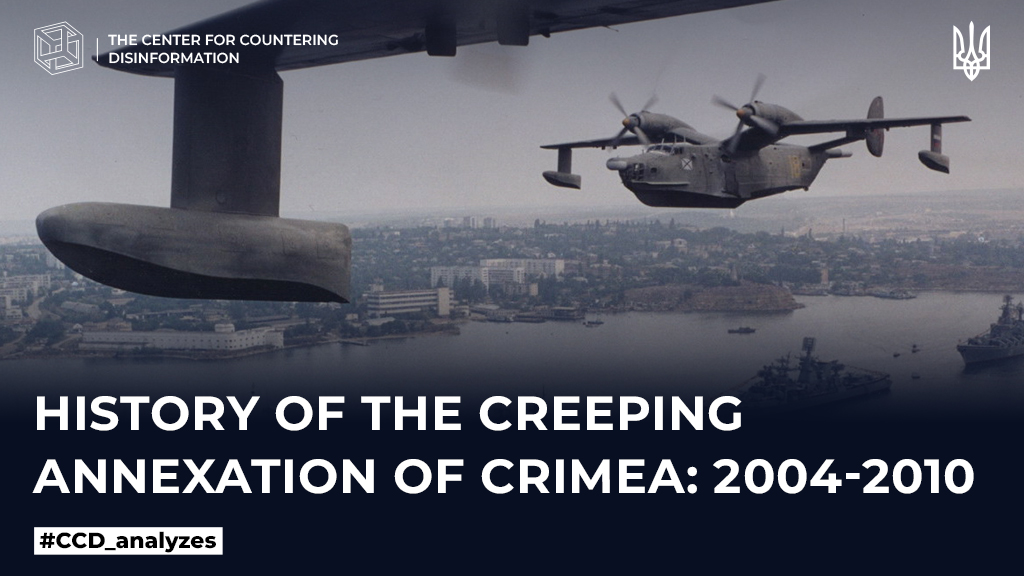The Orange Revolution of 2004 was a turning point for putin, which he saw as a personal defeat. After all, in the implementation of the scenario of the annexation of Crimea, putin was counting on V. Yanukovych. V. Yanukovych was actively supported in the presidential elections of Ukraine in 2004 by russia. As one of the participants in the annexation of Crimea, the so-called People’s Mayor of Sevastopol o.chaly, admitted, “in 2004-2005, we prepared for a coup in connection with the Orange Revolution for the first time.”
When it became clear that society would not allow Yanukovych to win against the background of accusations of election fraud, the basis of putin’s revanchist strategy became such an element of hybrid warfare as “soft power.” After the Orange Revolution, russia strengthens the ideological front in the ARC and Sevastopol and in every possible way fuels the pro-russian sentiments of the local population.
For this purpose, the russian special services formed an extensive network of anti-Ukrainian organizations in Crimea, controlled by the russian special services: the structures of the Party of Regions, the Communist Party of Ukraine, the Progressive Socialist Party of Ukraine, the parties “Rodina”, “russian Unity”, various Orthodox groups focused on the idea of the “russian world”, criminalized paramilitary organizations (security structures, fighting clubs, primarily the “Oplot” organization). Myths about eternal unity with the russian people, the so-called “triune, artificially divided russian people”, the advantages of joining either the newest russian empire or the USSR-2 were spread among the Crimeans. At the same time, the inability of the Ukrainian elites to develop the territory of the peninsula was proven. Idealist-pacifist ideas were aggressively imposed that the armed forces and other military formations of Ukraine are only a rudimentary attribute of the state, and they will never be used to protect the ARC. The kremlin also bet on Crimean criminality, which was supported by Ukrainian law enforcement agencies during the Yanukovych regime. It was the thoroughly criminalized Crimean organizations of the Party of Regions and the Communist Party of Ukraine that became a reliable pillar of russian influence and played a key role during the russian aggression and subsequent occupation. The kremlin fueled and exploited the international enmity between ethnic russians and the indigenous people of Crimea, the Crimean Tatars, and in every possible way incited xenophobic sentiments among the russian-speaking inhabitants of the peninsula. It was the scenario of the emergence of an armed confrontation due to international and ethno-religious contradictions between ethnic russians and Crimean Tatars and the subsequent transfer of the russian contingent of troops to protect the russians that was planned to be used for the annexation of Crimea. The confrontation in Crimea provoked by the special services and the armed forces of the russian federation should provide political and propaganda grounds for the invasion of russian troops into the eastern and southern regions of Ukraine.
In 2008, the kremlin considered a plan to seize Crimea during the return of the russian Black Sea Fleet to Sevastopol after the russian aggression against Georgia. At that time, President Yushchenko did not allow this to happen, signing a corresponding decree prohibiting the crossing of the Ukrainian border by ships of the russian Black Sea Fleet without the agreement of the Ukrainian side. The kremlin regarded the decree as a “serious anti-russian step”, but did not dare to take more radical actions.
In general, the rhetoric of the kremlin at that time seemed quite contradictory. On the one hand, in April 2008, in a conversation with US President G. Bush during the Bucharest NATO summit, putin stated that “Ukraine is not a state at all. Part of its territories is Eastern Europe, and a significant part was donated by us… If Ukraine joins NATO, it will leave without Crimea and the East – it will simply disintegrate.” And already in August 2008, when a journalist from the German TV channel ARD asked whether Crimea would be the next conflict after Georgia, putin assured that “Crimea is not a disputed territory and russia long ago recognized the borders of today’s Ukraine.”
However, since August 2008, the military and political leadership of russia began comprehensive measures for military and propaganda preparations for the annexation of Crimea and, in general, armed aggression against Ukraine. Units of russian military intelligence, under the guise of a “reconstruction movement” to recreate historical events, carried out reconnaissance of the future theater of hostilities in Crimea and Eastern Ukraine. Against the background of the analysis of the shortcomings that were discovered during the military conflict in South Ossetia, a large-scale military reform began in August 2008, which fundamentally changed the approach to the development and use of the armed forces of the russian federation.
❗️The period of 2004-2010 in the history of the Autonomous Republic of Crimea is characterized by the formation among the kremlin’s strategic idea of occupying the peninsula as a component of full-scale russian aggression against Ukraine.
To be continued…










